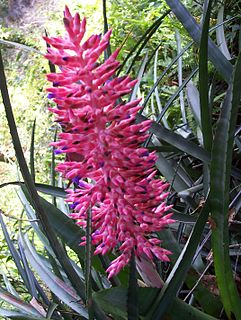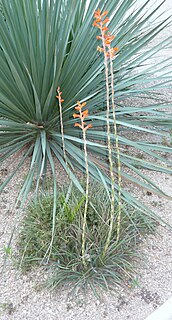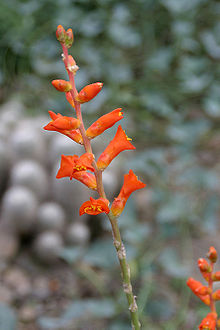
Aechmea bromeliifolia is a bromeliad native to southern Mexico, Central America, Trinidad, and South America as far south as northern Argentina.

Aechmea gamosepala is a bromeliad endemic to southern Brazil. It is often cultivated as an ornamental plant. This plant is cited in Flora Brasiliensis by Carl Friedrich Philipp von Martius

Aechmea nudicaulis is a bromeliad species in the genus Aechmea, which is often used as an ornamental plant. This species is native to Central America, the West Indies, central and southern Mexico, and northern and central South America.

Aechmea distichantha, the Brazilian vaseplant, or vase plant, is a bromeliad typical of Cerrado vegetation in Brazil, which is also native to northern Argentina, Bolivia, Paraguay, and Uruguay. This plant is often used as an ornamental plant.

Billbergia nutans, or Queen's-tears, is an epiphytic bromeliad native to Brazil, Paraguay, Uruguay, and Argentina.

Dyckia is a genus of plants in the family Bromeliaceae, subfamily Pitcairnioideae.

Dyckia leptostachya is a plant species in the genus Dyckia. This species is native to Brazil, Bolivia, Paraguay, and Argentina.

Aechmea lamarchei is a plant species in the genus Aechmea. It is endemic to eastern Brazil, known only from the States of Minas Gerais and Espírito Santo.
Aechmea alba is a species of plant in the genus Aechmea. This species is endemic to Brazil.
Aechmea bambusoides is a plant species in the genus Aechmea. This species is endemic to Brazil. It is native to the States of Minas Gerais and Rio de Janeiro. Mature fruits (berries) are pyriform, white and contain seeds spread in a fleshy transparent mucilage. Seeds are falcate-shaped, with a narrow micropylar portion, rough texture, brown-red colour and no appendages.
Aechmea burle-marxii is a plant species in the genus Aechmea. This species is endemic to Brazil, known from Bahia and Minas Gerais.
Aechmea organensis is a plant species in the genus Aechmea. This species is endemic to southeastern Brazil.

Aechmea purpureorosea is a plant species in the genus Aechmea. This species is endemic to southeastern Brazil, States of Minas Gerais and Rio de Janeiro.

Vriesea racinae is a plant species in the genus Vriesea. This species is an epiphyte endemic to Brazil. known from the States of Espírito Santo and Minas Gerais.

Tillandsia geminiflora is a species in the genus Tillandsia. This species is native to Brazil, Suriname, Paraguay, Uruguay, and the Misiones Province of Argentina.
Tillandsia polystachia is a species in the genus Tillandsia. This species is native to Central America, the West Indies, Bolivia, Colombia, Brazil, Ecuador, Mexico and Venezuela.

Aechmea lingulata is a plant species in the genus Aechmea. This species is native to the West Indies, Costa Rica, Panama and northern South America.
Dyckia macedoi is a plant species in the genus Dyckia. It is endemic to the State of Minas Gerais in Brazil.

Dyckia marnier-lapostollei is a plant species in the genus Dyckia, endemic to Brazil.

Dyckia remotiflora is a plant species in the genus Dyckia. It is native to Argentina, Uruguay, and Brazil.














